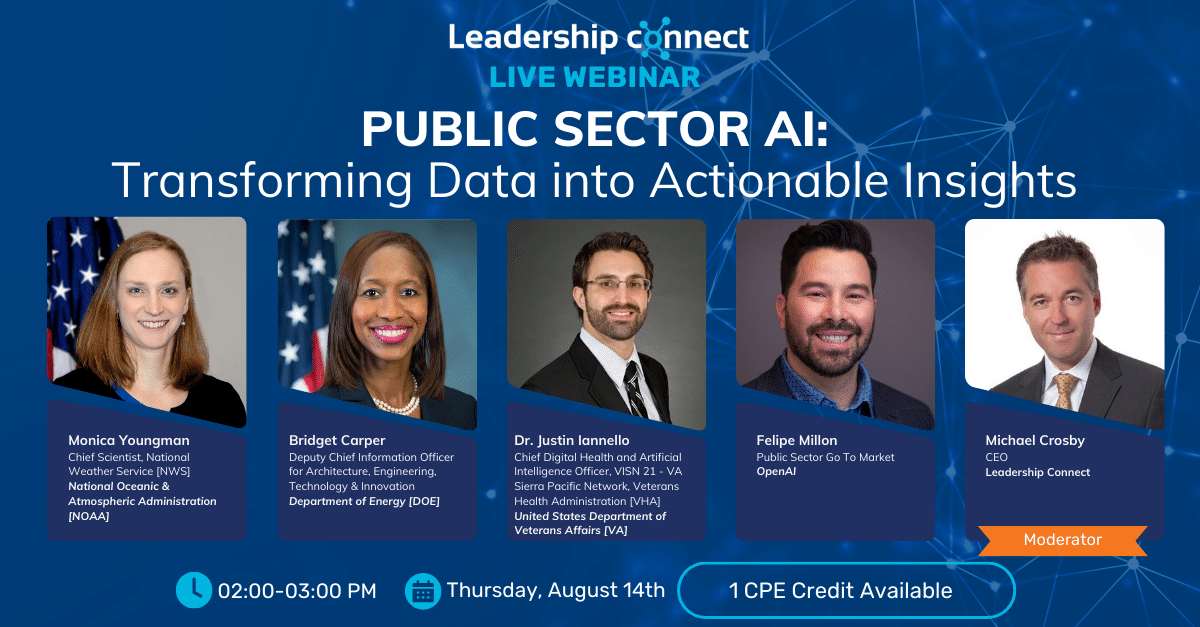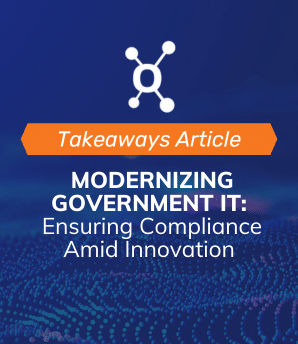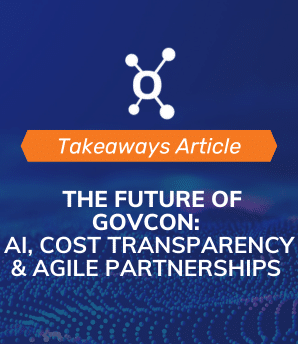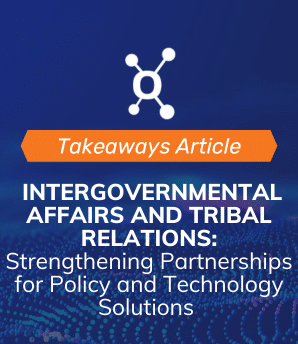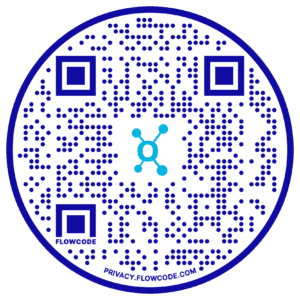Public Sector AI: Transforming Data into Actionable Insights
On Aug. 14, 2025, Leadership Connect hosted a conversation on the transformative role of artificial intelligence in government. The webinar, Public Sector AI: Transforming Data into Actionable Insights, explored how agencies are moving from theory to practice in applying AI to mission delivery and how they are working to make sense of the massive amounts of data they collect.
Panelists from government and industry shared perspectives on both opportunities and challenges, including improving data quality, expanding access to information, strengthening governance frameworks, building workforce literacy, and scaling successful pilots. Throughout the session, the themes of risk management, collaboration, and measurable impact were consistently at the forefront.
Missed the conversation? Check out the highlights below and watch the whole webinar here and make sure to follow our Events Page to get in on the next conversation.
Data Quality Determines AI Success
One of the clearest messages from the discussion was that AI projects succeed or fail based on the quality of the data. Poorly structured or inconsistent datasets often derail efforts before they can show value. Agencies stressed the importance of identifying where their data resides, cleaning it, and creating processes that ensure accuracy and reliability over time.
The conversation emphasized that AI initiatives must be rooted in well-defined problems and connected to the mission. Data-centric approaches, layered architectures, and integrated cloud solutions were cited as effective strategies for building confidence in outputs and avoiding wasted investment.
Balancing Experimentation and Risk
Experimentation is essential for building AI literacy and capability, but it must be balanced with safeguards. The panel highlighted that risk aversion is a major cultural and operational barrier in many agencies. Practical ways to lower the barrier include starting with low-risk use cases, adopting “learn by doing” approaches, and setting clear boundaries for testing.
This balance allows agencies to cultivate comfort with new tools while ensuring sensitive information and mission-critical functions remain protected. Encouraging staff to experiment with generative AI in controlled, everyday tasks was discussed as one way to build familiarity without exposing organizations to outsized risk.
AI Requires Training and Governance
Another theme was the importance of governance. AI was compared to a child that requires consistent training and oversight. Without proper guidance, outputs can become unpredictable or biased.
The session underscored that governance systems, including human review processes, bias detection, and adherence to federal executive orders, are essential to responsible AI adoption. Agencies that establish strong governance at the outset are better positioned to scale solutions safely and effectively.
Collaboration and Data Access Are Critical
Siloed data remains one of the top barriers to AI progress. The panel pointed to both technical and cultural hurdles in accessing and sharing information within and across agencies. Effective collaboration through working groups, peer-to-peer exchange, and interoperable systems was identified as a practical solution.
Examples shared included efforts to align AI and data teams, as well as initiatives to share workforce training approaches and operational insights across agencies. Breaking down silos enables AI systems to capture the full scope of government data and provide more accurate, actionable insights.
Defining Metrics and Scaling Adoption
Success in AI cannot be measured solely by technical performance. Agencies are increasingly aligning metrics with mission impact, such as improved forecasting, reduced processing times, or streamlined service delivery.
The discussion stressed the need to define metrics upfront, ensuring teams know what success looks like before projects begin. Scaling adoption requires demonstrating these early wins, then building on them iteratively. Iteration, persistence, and sharing lessons learned across agencies were highlighted as essential for sustainable AI growth.
AI Literacy Is a Moving Target
The panel noted that AI literacy looks different across roles and organizations. Unlike traditional technical training, the field evolves so quickly that what seems impossible today may be achievable in just a few months. Agencies are experimenting with ways to keep staff current—ranging from encouraging simple hands-on use of generative AI to structured internal training and cross-agency knowledge sharing. The consensus was clear: building comfort with AI is an ongoing process, not a one-time effort .
Scalability Requires Iteration and Flexibility
While pilots often deliver promising results, replicating success at scale can be far more difficult. The panel discussed how workflows, data variability, and technology maturity all introduce new challenges as projects expand. Iterative testing, persistence, and knowing when to pause or adjust an initiative were highlighted as practical approaches. Quick wins are valuable, but long-term adoption depends on the ability to adapt solutions across different use cases and organizational structures.
Building the Right Foundations for AI Adoption
The themes from this discussion made one thing clear: AI is only as strong as the data and connections that support it. Leadership Connect helps agencies build those foundations.
- Collab streamlines how teams capture, share, and act on institutional knowledge. Just as the panel underscored the importance of breaking silos, Collab provides a central space for tracking interactions, aligning stakeholders, and moving projects forward without duplication.
- Networks make it easier to discover and map relationships across agencies, industry, and Congress. In the same way AI benefits from interoperability, Networks empowers leaders to see how decision-makers are connected, anticipate shifts, and engage with the right people at the right time.
Across the platform, Leadership Connect delivers the accuracy and clarity that agencies need as they experiment, scale, and govern AI. With human-verified data, dynamic org charts, and real-time updates, public sector professionals can approach emerging technologies with confidence. By combining collaboration, relationship mapping, and trusted data, Leadership Connect equips teams to turn insights into action.
For a closer look at how Leadership Connect supports the public sector, explore our products to see how we can help you lead with clarity and confidence.
For a closer look at how our tools support smarter public sector decision-making, book a demo!



